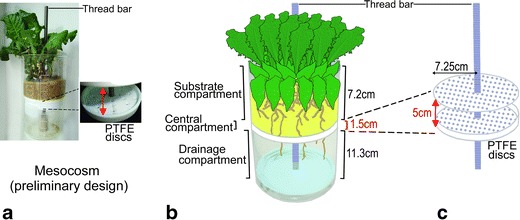Fig. 1.

Rhizosphere mesocosm for collection of root-derived volatile and water-soluble compounds. a The size of the mesocosm may be adapted to the number and size of plants: The mesocosm shown in this photo basically consisted of the same components as the mesocosm used in the experiments (except for the fleece in the substrate compartment), but a 1 L Schott beaker glass replaced the glass vessel. b The mesocosm consisted of a substrate compartment (filled with plant roots and sand), a central compartment (filled with humid air, buffer zone between substrate and drainage compartment), and a drainage compartment (containing leached aqueous nutrient solution that was not taken up by the plants and accumulated here over 5 d; approx. 5 mm, V = 80 ml solution in total). The plant roots grew through the perforated polytetrafluoroethylene (PTFE) discs (124 holes, diam 2 mm), which were mounted on a stainless steel thread bar (length: 25 cm, diam 1 cm). Due to static (passive) volatile collection on polydimethylsiloxane (PDMS) tubes, no artificial air flow was required. c The thread bar, which carried the PTFE discs, allowed gentle removal of rhizospheres prior to insertion of PDMS tubes for sampling of volatiles. Fleece surrounding the substrate minimized friction between the plant roots, substrate, and the glass vessel when removing the plant with root ball from the substrate compartment for insertion of PDMS tubes in the central and/or drainage compartment
